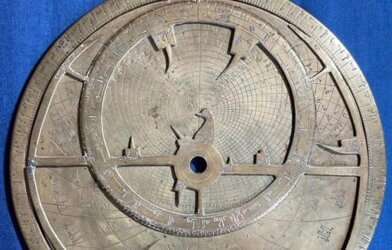VILLENA, Spain — In 1963, an astonishing trove of Late Bronze Age goldwork was discovered near the town of Villena in eastern Spain. Nicknamed “The Villena Treasure,” this cache dates back 3,500 years and contained elaborately decorated crowns, figurines, and jewelry rivaling those buried with famous pharaohs like King Tutankhamun. Now, scientists have made an even more astonishing discovery — some of those treasures contain metals originating in space!
Among the ultra-precious gold pieces, two anomalous artifacts stood out – a small hollow iron hemisphere and iron bracelet. Why would two ordinary iron objects be mixed in with what was clearly an elite collection of ceremonial items? The mystery deepened when an analysis revealed that the iron contained over five percent nickel. Researchers note this is simply too high for most iron ores found on Earth. So, where did this exotic metal come from?
The new study is finally putting the debate to rest. Researchers from the National Archeological Museum in Spain used special instruments to measure the nickel, cobalt, gallium, germanium, and other trace elements in tiny rust samples from the iron pieces. The chemistry closely matched known meteoritic material, pointing to an origin in space rather than mines here on Earth.
In other words, the Villena smiths cleverly worked with rare chunks of iron nickel that literally fell from the sky. Their skill transforming this cosmic gift into functional jewelry further demonstrates the sophistication of Bronze Age metalworkers.

Scientists Found Proof in the Chemistry
Most iron ore dug up from the Earth’s crust contains little nickel, usually less than one percent. However, iron-nickel meteorites typically contain over five percent nickel, along with cobalt and other trace metals in specific proportions. By measuring these chemical fingerprints, scientists can reliably identify when ancient societies used extraterrestrial rather than terrestrial iron.
For example, King Tut’s iconic iron dagger was recently confirmed to have meteoritic origins after extensive scanning. Its unmatched crystalline microstructure and nickel levels over 10 percent point to an outer space origin.
Likewise, nickel proportions over five percent in the Villena artifacts fall into the range for iron meteorites that originate from the cores of shattered asteroids. In addition, elevated amounts of gallium, germanium, and ruthenium match a specific type called an IAB complex meteorite.
While an Earth-based origin of this metal can’t be fully ruled out using non-destructive testing, the researchers argue that a cosmic origin is most plausible.
Rare Treasures from Space
Before iron smelting technology spread around 1200 BC, metalworkers who stumbled upon meteorites possessed a unique resource. The availability of these cosmic gifts waxed and waned based on chance meteorite falls. When a rock did fall from space, however, the sky-high value of the material enabled smiths to transform it into precious objects of power and status. For example, Ancient Egyptians produced rare beads, dagger blades, and headrests from meteoritic iron over 2,000 years before iron smelting took off in the region.
The presence of meteoritic jewelry in the Villena Treasure puts it among good company. The celestial origin renders the bracelet and cap even more splendid than previously thought. By precision working with this rare gift from the heavens, Bronze Age artisans demonstrated outstanding skill and created unique artifacts that literally outshine discoveries from other regions.
Study authors note that the space rocks that donated their iron may have plunged to Earth thousands or even millions of years prior to being discovered. However, they now give us deeper appreciation for ancient Spain’s technical prowess.
The findings are published in Trabajos de Prehistoria.



